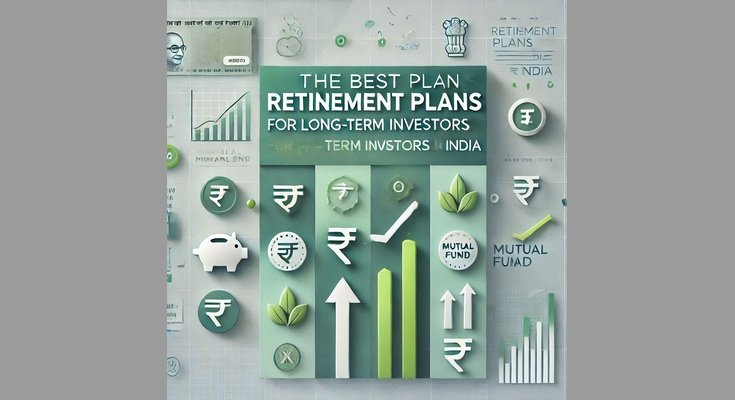The Best Retirement Plans for Long-Term Investors in India
The Best Retirement Plans:Retirement planning is a crucial financial goal that ensures a secure and comfortable life during your golden years. For long-term investors in India, selecting the right retirement plan involves understanding your financial needs, risk tolerance, and investment horizon. With numerous options available, it’s essential to evaluate and choose plans that offer consistent returns, tax benefits, and financial stability.
This article dives deep into the best retirement plans in India for long-term investors, providing practical examples, detailed explanations, and actionable insights. For more expert financial advice, visit RichPath.in and leave your comments below if you found this helpful!

Why Long-Term Investment is The Best Retirement Plans
Long-term investments are critical because they:
- Harness Compounding Power: Small, consistent contributions grow exponentially over time.
- Mitigate Risks: Market volatility smoothens out over the long term, reducing risks.
- Achieve Inflation-Adjusted Returns: Long-term plans ensure your savings outpace inflation.
Example: Investing ₹5,000 per month in a fund offering 10% annual returns can create a corpus of over ₹1 crore in 30 years.
Features of an Ideal Retirement Plan (Best Retirement Plans)
When choosing a retirement plan, look for the following:
- Safety of Capital: Plans should protect your principal amount.
- Consistent Returns: They must deliver inflation-adjusted returns.
- Tax Efficiency: Look for plans offering tax benefits under Indian laws.
- Flexibility: The ability to switch funds or adjust contributions as needed.
- Liquidity: Access to funds for emergencies without heavy penalties.
Best Retirement Plans for Long-Term Investors in India
1. Public Provident Fund (PPF)
- Why Choose It: PPF is a government-backed plan with assured returns and tax benefits.
- Features:
- Lock-in period: 15 years (extendable in blocks of 5 years).
- Tax benefits: Exempt-Exempt-Exempt (EEE) under Section 80C.
- Current interest rate: ~7.1%.
Example: Contributing ₹1.5 lakh annually can create a tax-free corpus of ₹40+ lakh in 20 years.
2. Employee Provident Fund (EPF)
- Why Choose It: Designed for salaried individuals, EPF offers a secure, employer-backed savings option.
- Features:
- Mandatory contributions: 12% of basic salary by the employee and employer each.
- Tax benefits: Contributions and interest are tax-free.
Example: A 30-year-old earning ₹50,000/month can build over ₹1 crore with EPF contributions over 25 years.
3. National Pension System (NPS)
- Why Choose It: NPS combines market-linked growth with pension benefits.
- Features:
- Two account types: Tier I (mandatory) and Tier II (optional).
- Flexibility: Choose between equity, corporate bonds, and government securities.
- Tax benefits: Additional ₹50,000 deduction under Section 80CCD(1B).
Example: Monthly contributions of ₹5,000 in an NPS account can create a corpus of ₹1 crore in 25 years, with a portion allocated for an annuity.
4. Equity Mutual Funds
- Why Choose Them: Ideal for long-term growth, equity mutual funds offer inflation-beating returns.
- Features:
- SIPs (Systematic Investment Plans) ensure disciplined investing.
- Tax efficiency: Long-term capital gains (LTCG) tax at 10% above ₹1 lakh.
Example: A SIP of ₹10,000 in an equity mutual fund with 12% annual returns can grow to ₹1 crore in 20 years.
5. Unit-Linked Insurance Plans (ULIPs)
- Why Choose Them: ULIPs combine investment and insurance benefits.
- Features:
- Flexibility to switch between equity and debt funds.
- Tax-free maturity proceeds under Section 10(10D).
Example: Investing ₹1 lakh annually in a ULIP can provide life cover and grow your corpus over 20 years.
6. Senior Citizens Savings Scheme (SCSS) (Best Retirement Plans)
- Why Choose It: SCSS offers secure, high-interest savings for retirees.
- Features:
- Eligibility: For individuals aged 60 or above.
- Interest rate: ~8% annually.
- Tax benefits: Contributions qualify for Section 80C deductions.
Example: Investing ₹15 lakh (maximum limit) in SCSS provides a steady income of ₹1.2 lakh annually.
7. Fixed Deposits (FDs) for Seniors (Best Retirement Plans)
- Why Choose Them: Bank FDs tailored for seniors offer slightly higher interest rates.
- Features:
- Flexibility: Choose tenure as per your need.
- Interest rates: ~6.5%-7.5% for senior citizens.
Example: A ₹10 lakh FD for 5 years at 7% interest yields ₹3.5 lakh in returns.
8. Real Estate Investments (Best Retirement Plans)
- Why Choose Them: Real estate provides rental income and capital appreciation.
- Features:
- Long-term wealth generation.
- Tax benefits on home loans under Sections 80C and 24.
Example: Investing in a ₹50 lakh property in a growing metro suburb can double its value in 15 years.
9. Gold Investments (Best Retirement Plans)
- Why Choose Them: Gold is a hedge against inflation and market volatility.
- Features:
- Options: Physical gold, ETFs, or Sovereign Gold Bonds (SGBs).
- Tax benefits: No capital gains tax on SGB redemption after maturity.
Example: Regular investments in SGBs can build a gold-backed corpus over 20 years.
How to Choose the Best Retirement Plan
1. Assess Your Risk Appetite
Younger investors can afford higher equity exposure, while older investors should prioritize stability.
2. Consider Inflation
Choose plans offering inflation-adjusted returns to maintain purchasing power.
3. Plan Regular Contributions
SIPs and recurring deposits ensure disciplined saving.
4. Diversify Investments (Best Retirement Plans)
Balance risk and reward by investing in a mix of equity, debt, and alternative assets.
Conclusion :Best Retirement Plans
Retirement planning is not just about saving but strategically investing to secure financial independence. By leveraging options like PPF, NPS, equity funds, and real estate, you can build a robust retirement corpus tailored to your needs. Start early, invest consistently, and review your portfolio regularly to stay on track.
For more expert financial insights, visit RichPath.in. If you liked this article, share it with others and let us know your thoughts in the comments below. Together, let’s create a path to financial freedom!
Read more –
How Long-Term Investments Can Secure Your Retirement
How to Plan Your Retirement in Your 40s with Just ₹1,000 Monthly Using Mutual Funds








